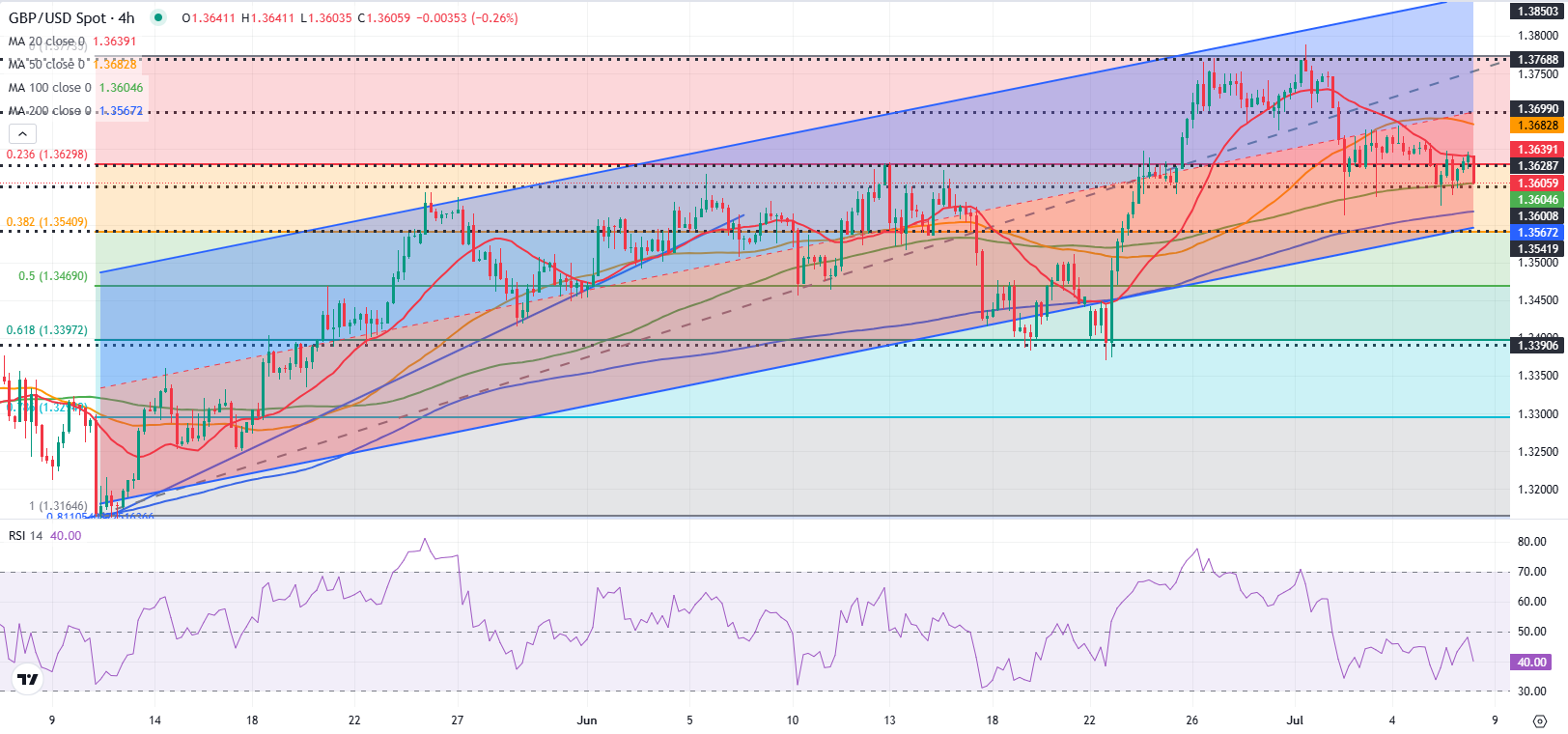- GBP/USD holds slightly above 1.3600 in the European session.
- The technical outlook highlights a lack of buyer interest.
- The risk mood is likely to continue to drive the pair’s action in the near term.
After losing more than 0.3% on Monday, GBP/USD staged a rebound early Tuesday but failed to gather momentum. The pair stays in a consolidation phase slightly above 1.3600 in the European session.
British Pound PRICE This week
The table below shows the percentage change of British Pound (GBP) against listed major currencies this week. British Pound was the weakest against the US Dollar.
| USD | EUR | GBP | JPY | CAD | AUD | NZD | CHF | |
|---|---|---|---|---|---|---|---|---|
| USD | 0.35% | 0.37% | 1.42% | 0.39% | 0.30% | 0.75% | 0.39% | |
| EUR | -0.35% | 0.04% | 0.82% | 0.02% | 0.01% | 0.39% | 0.03% | |
| GBP | -0.37% | -0.04% | 0.78% | 0.00% | -0.01% | 0.37% | -0.13% | |
| JPY | -1.42% | -0.82% | -0.78% | -0.80% | -0.90% | -0.45% | -0.96% | |
| CAD | -0.39% | -0.02% | -0.00% | 0.80% | -0.07% | 0.37% | -0.13% | |
| AUD | -0.30% | -0.01% | 0.01% | 0.90% | 0.07% | 0.48% | -0.13% | |
| NZD | -0.75% | -0.39% | -0.37% | 0.45% | -0.37% | -0.48% | -0.49% | |
| CHF | -0.39% | -0.03% | 0.13% | 0.96% | 0.13% | 0.13% | 0.49% |
The heat map shows percentage changes of major currencies against each other. The base currency is picked from the left column, while the quote currency is picked from the top row. For example, if you pick the British Pound from the left column and move along the horizontal line to the US Dollar, the percentage change displayed in the box will represent GBP (base)/USD (quote).
The cautious market mood helped the US Dollar (USD) gather strength at the beginning of the week and caused GBP/USD to push lower.
Although the White House announced that the deadline for the implementation of tariffs will be pushed to August 1, safe-haven flows dominated the action as the letters sent out by US President Donald Trump to trading partners showed that Japan and South Korea were to face 25% tariffs. After Wall Street’s main indexes closed deep in negative territory on Monday, US stock index futures trade mixed in the European session on Tuesday.
The economic calendar will not offer any high-impact macroeconomic data releases. Hence, investors are likely to continue to react to changes in risk perception.
In case major equity indexes in the US remain under bearish pressure following the opening bell, GBP/USD could find it hard to extend its recovery. On the flip side, the USD could struggle to find demand and allow the pair to regain its traction if risk flows dominate the action in financial markets in the second half of the day.
GBP/USD Technical Analysis

The Relative Strength Index (RSI) indicator on the 4-hour chart retreated to 40 after recovering to the 50 area earlier in the day, reflecting buyers’ hesitancy.
The 100-period Simple Moving Average (SMA) aligns as the immediate support level at 1.3600 before 1.3565 (200-period SMA) and 1.3540 (Fibonacci 38.2% retracement of the latest uptrend). On the upside, 1.3630 (20-period SMA) could be seen as an interim resistance level ahead of 1.3690-1.3700 (50-period SMA, mid-point of the ascending channel).
Pound Sterling FAQs
The Pound Sterling (GBP) is the oldest currency in the world (886 AD) and the official currency of the United Kingdom. It is the fourth most traded unit for foreign exchange (FX) in the world, accounting for 12% of all transactions, averaging $630 billion a day, according to 2022 data.
Its key trading pairs are GBP/USD, also known as ‘Cable’, which accounts for 11% of FX, GBP/JPY, or the ‘Dragon’ as it is known by traders (3%), and EUR/GBP (2%). The Pound Sterling is issued by the Bank of England (BoE).
The single most important factor influencing the value of the Pound Sterling is monetary policy decided by the Bank of England. The BoE bases its decisions on whether it has achieved its primary goal of “price stability” – a steady inflation rate of around 2%. Its primary tool for achieving this is the adjustment of interest rates.
When inflation is too high, the BoE will try to rein it in by raising interest rates, making it more expensive for people and businesses to access credit. This is generally positive for GBP, as higher interest rates make the UK a more attractive place for global investors to park their money.
When inflation falls too low it is a sign economic growth is slowing. In this scenario, the BoE will consider lowering interest rates to cheapen credit so businesses will borrow more to invest in growth-generating projects.
Data releases gauge the health of the economy and can impact the value of the Pound Sterling. Indicators such as GDP, Manufacturing and Services PMIs, and employment can all influence the direction of the GBP.
A strong economy is good for Sterling. Not only does it attract more foreign investment but it may encourage the BoE to put up interest rates, which will directly strengthen GBP. Otherwise, if economic data is weak, the Pound Sterling is likely to fall.
Another significant data release for the Pound Sterling is the Trade Balance. This indicator measures the difference between what a country earns from its exports and what it spends on imports over a given period.
If a country produces highly sought-after exports, its currency will benefit purely from the extra demand created from foreign buyers seeking to purchase these goods. Therefore, a positive net Trade Balance strengthens a currency and vice versa for a negative balance.

